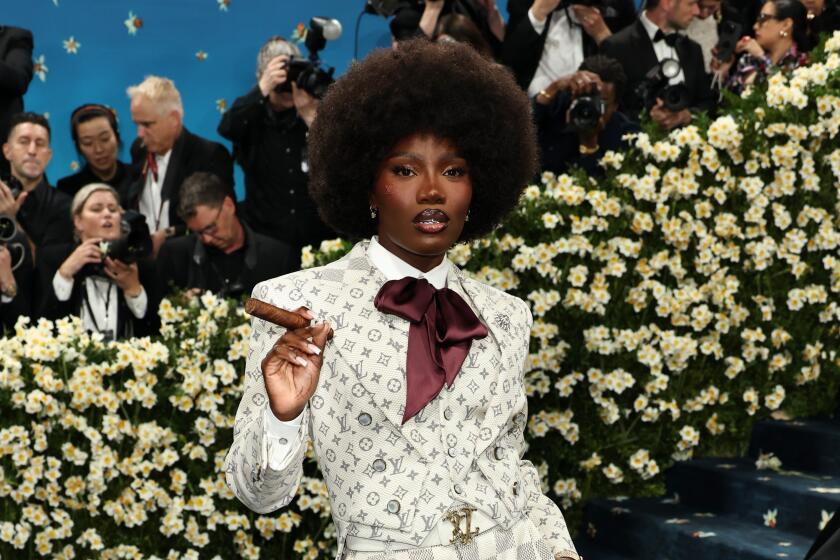Artists Get a Lift Onto ‘Info Superhighway’
- Share via
Kit Galloway says artists are afraid of technology. Computers, microprocessors, satellite linkups, videophones--they tend to scare away folks who are more at ease with, say, watercolors, or dance floors, or a pad and pen.
“There’s a lot of fear out there,” he said.
To combat that terror, and to help artistic types find creative expression using the very technologies they may abhor, Galloway and his partner, Sherrie Rabinowitz, run the Electronic Cafe International, a sort of bohemian hangout for the Internet crowd. The cafe, tucked in a quiet corner of Santa Monica’s 18th Street Arts Complex, looks like the result of a high-speed crash of a Circuit City delivery truck into a Greenwich Village coffeehouse.
It’s a place where patrons sip java and use video telephones and computer hookups to schmooze with like-minded people at the far reaches of the planet.
“We took the model of the indigenous community cafe,” Galloway said, “and blew it out to the scale of international global telecommunications.”
Americans take the telephone for granted, Galloway said, but many have come to associate high-tech communications only with network television and Fortune 500 boardrooms. Anyone can flip on “Nightline” and watch Ted Koppel hold a round-table discussion via satellite. But when was the last time you gave it a try yourself?
“Instead of pulling up to a mahogany electronic meeting table with fixed microphone positions, we wanted it to be a theater, a cabaret, a soiree--a chameleon-type place.”
Galloway, 46, and Rabinowitz, 44, have been collaborating on interactive video projects since they met in Paris in 1975. They opened the cafe in 1989. The idea was to take advantage of the capacity for instantaneous global communications, to create a place where artists, writers, poets, musicians and others could collaborate with cohorts around the world.
With an espresso bar and a small menu of desserts, the establishment is aimed at drawing people without a technical proclivity into the realm of high-tech communications. “A lot of people come in here,” said Rabinowitz, “and they don’t know about all this equipment. But they know coffee. They can understand coffee.”
The cafe has sponsored poetry readings with poets reading simultaneously in San Francisco, New York and Santa Monica. Each New Year’s Eve, the cafe holds celebrations in collaboration with affiliates around the world, marking the stroke of midnight in such far-flung locales as Tokyo, Berlin, Managua and Maui. Using interactive computer graphics, artists in Paris and Santa Monica have jointly concocted electronic artworks.
Rabinowitz and Galloway’s establishment, the flagship, has more than 40 affiliates throughout the world, in cities including Rio de Janeiro, Paris and Berlin. “It’s so big now that it’s hard for us to keep up,” Rabinowitz said. The cafe has no regular hours. It opens two or three times weekly for special events.
Today, the cafe will help inaugurate an affiliate in Jerusalem. At 10:30 a.m. Santa
Monica time, visitors to the cafe will watch a live musical performance, via videophone, from the Jerusalem Theater.
Afterward, participants will hold a discussion with a group of musicians. Though the technology sounds intimidating to the lay person, the proprietors insist they are using equipment available to anyone. They’ve gone out of their way to avoid high-end, technically overwhelming gear.
“Every cafe has to have at least a little black-and-white videophone, which operates on ordinary dial-up-order-a-pizza telephone lines,” said Rabinowitz. “That way, everybody can talk to everybody.”
The cafe also has hookups to the Internet--an international on-line computer system--as well as facilities for transmitting high-tech color images. Before they opened the cafe, Rabinowitz, a trained architect, and Galloway had collaborated on a series of ventures taking advantage of cutting-edge interactive technology.
In 1980, they conducted the “Hole in Space” project, creating a satellite link between two large video screens--one in a Century City department store window, the other on a Manhattan street. The three-day spontaneous experiment had people on both coasts lining up to catch a glimpse of life across the country.
The couple created the prototype for the electronic cafe when the Museum of Contemporary Art commissioned them to concoct a project for the 1984 Los Angeles Olympic Arts Festival. Galloway and Rabinowitz installed computers and videophones in four neighborhood cafes--in South-Central, East Los Angeles, Venice and Koreatown--and at MOCA.
Local residents communicated with each other, creating art, discussing the world, and sharing words and images using the equipment. In a city noted for its geographical divisiveness, the project helped forge links between people who might not otherwise have become acquainted.
“We wanted to create a space where people could start to experience this technology and appreciate the values of using it and what might be lost by not using it,” Galloway said.
Looking for a way to bring that concept to an international scale, the couple used the Olympics project as a model for their Santa Monica establishment.
“We looked at all human institutions and came to the conclusion that the one to reaffirm is the culturally indigent informal public face, where people meet and talk and conspire,” Galloway said. “Of all our institutions, the informal ones are often the ones that get things done.”
The excitement of the electronic cafe, Rabinowitz said, comes with the mix of people--and the cross-pollination of talent and ideas: “So you have computer people here, and you have poets, and they hang out together. All of a sudden, you find out that the computer person is really a closet poet.”
More to Read
The biggest entertainment stories
Get our big stories about Hollywood, film, television, music, arts, culture and more right in your inbox as soon as they publish.
You may occasionally receive promotional content from the Los Angeles Times.










